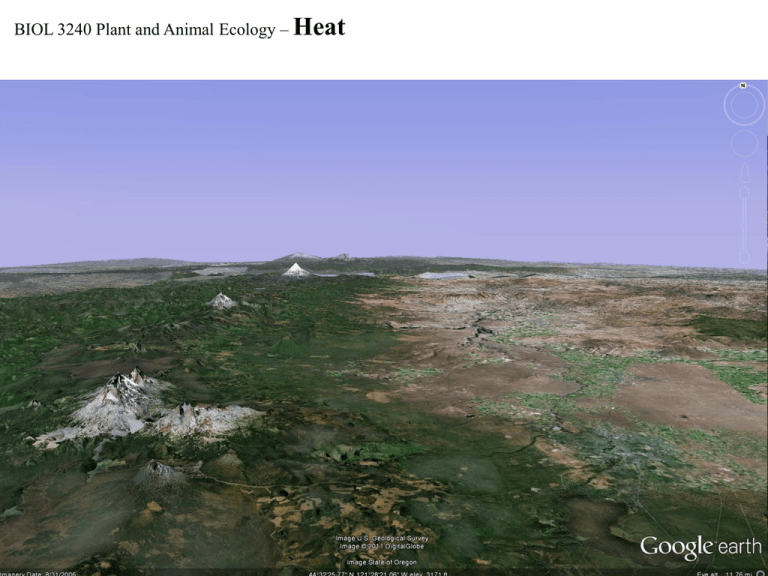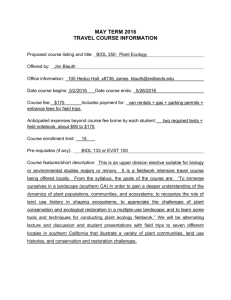Notes
advertisement

BIOL 3240 Plant and Animal Ecology – Heat BIOL 3240 Plant and Animal Ecology – Heat • • : Large scale weather variation. : Small scale weather variation, usually measured over shorter time period. – • Higher altitude - lower temperature. – • Offers contrasting environments. – • Ecologically important microclimates. © Getty Images/Taxis • Ground Color – Darker colors absorb more visible light. • Boulders / Burrows – Create shaded, cooler environments. Factor? Factor? Factor? Factor? BIOL 3240 Plant and Animal Ecology – Heat • – Darker colors absorb more visible light. • – Create shaded, cooler environments. BIOL 3240 Plant and Animal Ecology – Heat • – Absorbs heat without changing temperature. • 1 cal energy to heat 1 cm3 of water 1o C. – Air - .0003 cal • – When 1g H2O evaporates it absorbs 580 cal. • – 1 g of water gives off 80 cal as it freezes. • BIOL 3240 Plant and Animal Ecology – Heat • Riparian vegetation influences stream temperature by … Which region? Which region? Which region? Which region? BIOL 3240 Plant and Animal Ecology – Heat • Biomolecular Level – Most enzymes … • _____________________cause low reaction rates, while ________________________________destroy the shape. – Baldwin and Hochachka studied the influence of temperature on performance of acetylcholinesterase in rainbow trout (Oncorhynchus mykiss). BIOL 3240 Plant and Animal Ecology – Heat Optimal Photosynthetic Temperatures BIOL 3240 Plant and Animal Ecology – Heat • Photosynthesis – Extreme temperatures usually __________ rate of photosynthesis. • Different plants have _________ optimal temperatures. • ___________________: Physiological changes in response to temperature. BIOL 3240 Plant and Animal Ecology – Heat BIOL 3240 Plant and Animal Ecology – Heat Temperature and Microbial Activity • Morita studied the effect of temperature on population growth among ____________ marine bacteria around Antarctica. – Grew fastest at 4o C. – Some growth recorded in temperatures as cold as - 5.5o C. • Some ___________ microbes have been found to grow best in temperatures as hot as 110o C. BIOL 3240 Plant and Animal Ecology – Heat Heat Exchange Pathways BIOL 3240 Plant and Animal Ecology – Heat Balancing Heat Gain Against Heat Loss • HS = Hm Hcd Hcv Hr - He – HS = – Hm = – Hcd = – Hcv = – Hr = – He = BIOL 3240 Plant and Animal Ecology – Heat Body Temperature Regulation • – Body temperature varies directly with environmental temperature. • – Rely mainly on external energy sources. • – Rely heavily on metabolic energy. • – Maintain a relatively constant internal environment. BIOL 3240 Plant and Animal Ecology – Heat Temperature Regulation by Plants • Desert Plants: Must __________ heat storage. – Hs = Hcd Hcv Hr – To avoid heating, plants have (3) options: • • • – What about He & Hm? BIOL 3240 Plant and Animal Ecology – Heat Temperature Regulation by Plants BIOL 3240 Plant and Animal Ecology – Heat • Arctic and Alpine Plants – Two main options to stay warm: • • • Tropic Alpine Plants – Rosette plants generally retain dead leaves, which insulate and protect the stem from freezing. • ____________increases leaf temperature. BIOL 3240 Plant and Animal Ecology – Heat Temperature Regulation by Ectothermic Animals • Eastern Fence Lizard (Sceloporus undulatus) – Metabolizable energy intake maximized at 33ºC – Preferred temperature ______________ the temperature at which metabolizable energy intake is maximized • Grasshoppers – Some species can adjust for _______ heating by varying intensity of pigmentation during development. http://miriadna.com/foto/560 BIOL 3240 Plant and Animal Ecology – Heat Thermal Neutral Zones BIOL 3240 Plant and Animal Ecology – Heat Temperature Regulation by Endothermic Animals • Swimming Muscles of Large Marine Fish & Mammals – Lateral swimming muscles of many fish (Mackerel, Sharks, Tuna) are well supplied with blood vessels that function as __________________________. • BIOL 3240 Plant and Animal Ecology – Heat Countercurrent Heat Exchange What heat transfer type is important here? What heat transfer type is important here? What heat transfer type is important here? BIOL 3240 Plant and Animal Ecology – Heat Pop Quiz! Describe the “thermy” of this animal… BIOL 3240 Plant and Animal Ecology – Heat • Warming Insect Flight Muscles – Bumblebees maintain temperature of thorax … – Sphinx moths (Manduca sexta) … • Thermoregulates by … BIOL 3240 Plant and Animal Ecology – Heat Moth Circulation and Thermoregulation BIOL 3240 Plant and Animal Ecology – Heat Temperature Regulation by Thermogenic Plants • Almost all plants are … – Plants in family Araceae use ______________ to heat flowers. – Skunk Cabbage (Symplocarpus foetidus) stores large quantities of starch in large root, and then translocate it to the inflorescence … BIOL 3240 Plant and Animal Ecology – Heat Eastern Skunk Cabbage Snow melts why? ? ? Snow melts why? ? ? BIOL 3240 Plant and Animal Ecology – Heat Surviving Extreme Temperatures • – Seek shelter during extreme periods. • – Hummingbirds enter a state of torpor when food is scarce and night temps are extreme. – - Winter – – Summer – Wood frogs… (http://www.youtube.com/watch?v=uRx_cl826Mo) BIOL 3240 Plant and Animal Ecology – Heat






